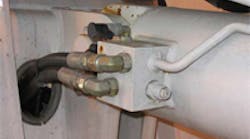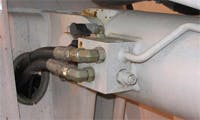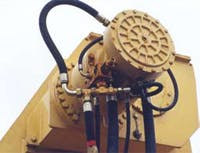By Pat Jones
P.Eng. CFP Ltd.
The level of load control in hydraulic load-motion control systems is determined by the safety requirements of the particular application. For example, can human safety be ensured by properly guarding the lifting system? Is the load a person — as in an aerial lift? Can unintended lowering of the load cause machine damage? When working on any hydraulic system, the system load controls must be clearly understood.
When hydraulic system failure or malfunction leaves the load in the raised position, it may be desirable to lower the load, either for pure safety reasons, to get a vehicle back to the shop, or because of production delays. In this case the method of load control being used and how it can be safely overridden must be clearly understood.
If you are not comfortable performing the following emergency procedures, you need some training. You can consult the equipment manufacturer, work with an experienced technician within your company, or find a hydraulic specialist to train you on the correct procedure.
Safe load lowering
If the engine of a bucket truck cannot be started, the vehicle may be equipped with an emergency power pump that can lower the boom safely. If it isn’t, the load can be lowered by the pressure setting of the counterbalance valve in the boom cylinder.
This procedure can only be undertaken with no operator in the bucket! Before adjusting the valve, make sure you know the correct direction to turn the adjusting screw. Several brands of counterbalance valves have adjustments that increase the pressure setting when turned counterclockwise and decrease the pressure setting (load-holding ability) when turned clockwise.
Because a counterbalance valve is a pressure control, you should adjust it slowly. If you adjust the pressure setting too quickly, you may reduce it too much and create a runaway load. The load will start to move once the pressure setting on the valve is close to the load pressure.
Do not adjust any further. Wait to see how fast the load moves. The speed may increase as the load lowers due to changes in geometry. Don’t rush. Adjust the valve to speed up or slow down accordingly. Let the load slowly creep down until the boom is at rest. Once it is, immediately reset the valve to maximum. It will have to be properly set at a later date, but this ensures it will hold.
Motor-brake drives In the case of a hydraulic motor driven winch, a counterbalance valve will not hold the load because of internal leakage in the hydraulic motor. Therefore, a spring-applied, hydraulically released brake is used. If a power failure occurs with a load in the air, the brake must be released carefully to lower the load. This can be accomplished by using a hand pump.
There must be a way to adjust flow to the motor’s brake to limit pressure. Also, the hand pump must be equipped with a bypass valve, which allows pump flow to go back to the reservoir. The bypass valve should never be closed during this procedure. By keeping the bypass valve open, pressure can only be maintained to release the brake if the hand pump lever is continually operated. This makes it easy to stop the load by not pumping the hand pump.
Using a second winch to support the load during this operation prevents the possibility of a runaway load. With the brake release line disconnected from the circuit, connect the hand pump to the brake release line. Be sure to close and seal the open line. Never troubleshoot or test with open ports or lines.
With the hand pump’s bypass valve open, start pumping the hand pump. Slowly close the bypass valve while pumping and observe the load. When the load starts to move, the brake has been released — stop pumping to make sure the load stops.
Start pumping again and close the bypass valve a little more so the load moves a reasonable amount — approximately 3 to 4 in. — for one stroke of the hand pump. Again, do not be in a hurry, and never close the bypass valve — otherwise a runaway load could occur.
A similar procedure can be used for slew-drive brakes, but you must have control of the load with chain falls, a winch, or some other means to prevent a runaway load from occurring. It may be possible in some applications to connect to the external pilot of a counterbalance valve and release it in a controlled fashion — similar to that with a spring-applied, hydraulically released brake.
Emergency load lowering should only be undertaken by trained personnel. Once the procedures are fully understood, however, accepted methods exist to put the machine into a zero energy, safe state.
Pat Jones, P.Eng., is a Hydraulic System Specialist with CFP Ltd., Dartmouth, Nova Scotia. CFP offers hydraulic training, including standard and customized programs, throughout North America. To see class schedules or sign up for his “Hydraulic Talk” newsletter, visit www.cfp.ns.ca, or call (902) 468-8814.



